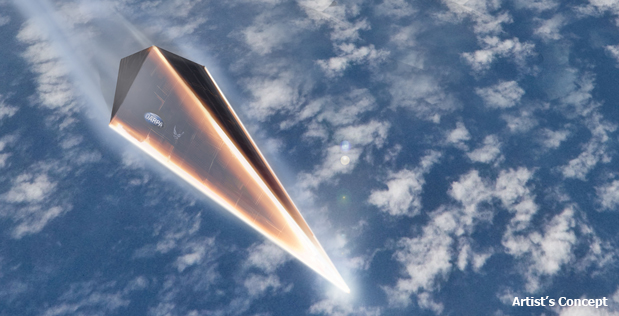Shredding through the air at more than five times the speed of sound, hypersonic craft create incredible amounts of friction.
The Defense Advanced Research Projects Agency (DARPA) seeks to develop and demonstrate new design and material solutions for sharp, shape-stable, cooled leading edges for hypersonic vehicles.
Read More: DARPA wants to launch rapid payloads into space on a whim
In order to make sure that these craft flying at speeds over Mach 5 don’t burn up in flight, DARPA will hold a Proposers Day on January 22, 2019 in Arlington, Virginia for its Materials Architectures and Characterization for Hypersonics (MACH) program.
“We could see a breakthrough in mitigating aerothermal effects at the leading edge that would enhance hypersonic performance”
The goals of the MACH Proposers Day are to:
- Introduce the research community to the MACH program vision and goals.
- Explain the mechanics of a DARPA program and the milestones of this particular effort.
- Encourage and promote teaming arrangements among potential organizations that have the relevant expertise, facilities, and capabilities for executing a research and development program responsive to the MACH program goals.

Bill Carter
“For decades people have studied cooling the hot leading edges of hypersonic vehicles but haven’t been able to demonstrate practical concepts in flight,” said Bill Carter, program manager in DARPA’s Defense Sciences Office.
“The key is developing scalable materials architectures that enable mass transport to spread and reject heat. In recent years we’ve seen advances in thermal engineering and manufacturing that could enable the design and fabrication of very complex architectures not possible in the past.
“If successful, we could see a breakthrough in mitigating aerothermal effects at the leading edge that would enhance hypersonic performance,” he added.
Read More: Brain-computer interface allows for telepathic piloting of drones
According to the University of Michigan College of Engineering Aerospace Engineering Department, “Hypersonic vehicles travel much faster than the speed of sound, typically at Mach 5 or higher. They are being developed for applications from national security to space exploration.
“The term hypersonic implies that there are unique physical phenomena that are important for these vehicles that do not occur at lower speed. Such phenomena are generated by the very high-temperature gas that surrounds a hypersonic vehicle, and examples include air chemistry and material ablation.”
DARPA is now looking for innovative approaches that enable revolutionary advances in the materials, design and implementation of shape-stable, high heat flux capable leading edge systems. Specifically excluded is research that primarily results in evolutionary improvements to the existing state of practice.
The MACH program will be comprised of two technical areas. The first area aims to develop and mature fully integrated passive thermal management system to cool leading edges based on scalable net-shape manufacturing and advanced thermal design.
The second technical area will focus on next-generation hypersonic materials research, applying modern high-fidelity computation capabilities to develop new passive and active thermal management concepts, coatings and materials for future cooled hypersonic leading edge applications.
Read More: DARPA wants to make AI a ‘collaborative partner’ for national defense
DARPA seeks expertise in thermal engineering and design, advanced computational materials development, architected materials design, fabrication and testing (including net shape fabrication of high temperature metals, ceramics and their composites), hypersonic leading-edge design and performance, and advanced thermal protection systems.












